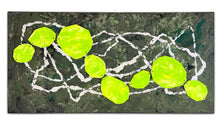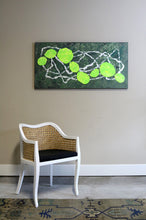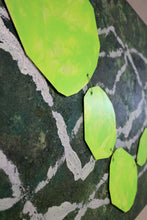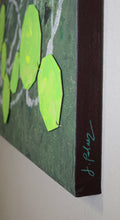"Accept the Is-ness"
Regular price
$1,500.00
Sale
48" x 24", Mixed media, illustration board, grommets, wire, sand, fig edges
ART INSPIRATION //
We make observations every day. But it is the human condition to inject judgement into those observations. Judging happens often automatically, instantaneously, and subconsciously, based on previous first-hand experiences or learned behaviors. We categorize things as "good/bad", "right/wrong" and often read meaning into benign events/things/people that can spin us into a story that in the end, isn't even true. In every day life, this could be me judging myself over an art show rejection, or assuming someone is mad at me when they don't text me back right away. The thoughts in our head become our version of reality so why feed ourselves unverified negative conclusions? While it may feel comforting to fill in the blanks, there are so many factors that we could never perceive. The power that comes with detaching from judgement or not writing a "story to tell ourselves" as Brené Brown would say, is that we create space for seeing this as they are. With that open acceptance, we can let go of superfluous meaning and instead invite in truth, possibilities and a chance for expansion. We can maintain a more calm level of thinking and be more available to connect with what or who is in front of us.
As funny as it may seem, this conscious shift to "is-ness" as Ram Dass would call it, was never more immediately noticeable than in my time on the tennis court. Rather than judging a ball "good" or "bad" based on its relationship to an arbitrary line on a court, I took it in as only information and neutral feedback. The ball was just on the path it had been set it on. I didn't get frustrated when I had a string of errors, or didn't fall into the downward spiral that one bad ball meant I was a bad player. As we know, thoughts effect mood, and even our body chemistry. Staying light and positive, rather than getting weighed down and tight from negative thinking was immediately felt in my body, as well as in my performance. I was able to openly accept the mistakes and reset for the next point.
SYMBOLISM //
Compositionally, this artwork is my interpretation of this tennis example. The background mimics the color of gray clay courts, will actual sand grit sprinkled throughout. I purposely wanted the white lines of the court to be meaningless, (as they are to the ball itself), and created them by rolling a paint-drenched tennis ball around the canvas. The abstract tennis ball shapes carve a bouncing path across the canvas. Not good, not bad. Just is.
RECOMMENDED RESOURCES //
- Ram Dass: "How to Love Yourself"
- Brené Brown "The Call to Courage" on Netflix










